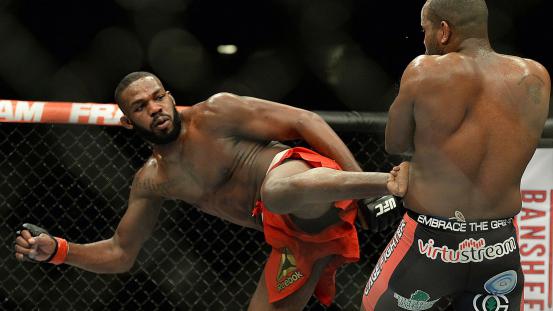- Commissioner’s statement on Ventura, Marte
- Ronnie O’Sullivan: Masters champion ‘felt so vulnerable’ in final
- Arron Fletcher Wins 2017 WSOP International Circuit Marrakech Main Event ($140,224)
- Smith challenges Warner to go big in India
- Moncada No. 1 on MLB Pipeline’s Top 10 2B Prospects list
- Braves land 2 on MLB Pipeline’s Top 10 2B Prospects list
- Kingery makes MLB Pipeline’s Top 10 2B Prospects list
- New Zealand wrap up 2-0 after Bangladesh implosion
- Mathews, Pradeep, Gunathilaka to return to Sri Lanka
- Elliott hopes for rain for Poli
UFC 197 Judo Chop: The Transitions of Jon Jones and Demetrious Johnson part 2
- Updated: April 22, 2016

Fighting lives in the transitions. The spaces and moments between positions and phases, distances and angles. When the opponent moves his head or his feet, or creates a wild scramble, that’s when fighters like Khabib Nurmagomedov, Dominick Cruz, Frankie Edgar, and Cain Velasquez prove themselves to be truly dangerous. And elite as that group of fighters may be, Jon Jones and Demetrious Johnson are even better.
At UFC 197, Jones and Johnson will face two very different opponents. For Jones, a late-notice replacement will serve as something of a tuneup for his eventual rematch with Daniel Cormier, who currently wears the belt that once fit so comfortably around his waist. For Demetrious Johnson, an Olympic gold medalist with relentless kickboxing looks to change the landscape of the flyweight division for good. And yet both men will use a remarkably similar set of skills and techniques in their pursuit of victory.
PART TWO – POSITIONS AND PHASES
In yesterday’s part one, we focused on the closing of distance. But what happens when the distance has already been closed? Both Jones and Johnson are exceptional clinch fighters and powerful takedown artists.
Many believe that Jon Jones fights in the clinch despite himself, as if his height is a detriment in close quarters and he pursues that phase merely to challenge himself. On the contrary, height and length are powerful weapons in the clinch. The moment Jon Jones clinches, his knees are terrifyingly close to his opponent’s chin, and mere inches below his abdomen. His long arms can entangle limbs or yank down on the back of the neck with surprising ease. And by bending his knees he can get below his opponent and generate tremendous lift merely by standing back upright.
Against Rashad Evans, Jones showed how the transitional fighter creates openings in the clinch.
GIF
1. Rashad Evans moves toward Jones with a feint.
2. As the feint turns into a 1-2, Jones slides in under the right hand.
3. And quickly establishes inside control on Rashad’s right biceps.
4. As Evans works for an underhook with his opposite arm, Jones slides his hand down into wrist control.
5. Exploding upward, Jones checks Evans’ chin with his shoulder.
6. Rashad drives his forehead into Jon’s chest to avoid the shoulder shots, and tries to free his wrist.
7. The only way to get enough space to do this, however, is to step back at an angle.
8. Jones senses the opportunity. He gives up the wrist, shoves Evans’ chest with his now free hand, and blocks his foot.
9. Evans tumbles to the canvas.
10. Transitions are everywhere; Jones pounces and lands a right hand as Rashad attempts to sit up.
Jones’ elbows and uppercuts get more attention nowadays, but his shoulder shots are a sneakily effective weapon. Like the face-slaps of Demetrious Johnson, a shoulder shot is unlikely to do significant damage, but it certainly doesn’t feel good. And because Jones is happy to keep using it as long as the opening is there, the technique demands a reaction from the opponent–a reaction Jones can use. And because Jones can strike with the shoulder while maintaining wrist control on the same side, his opponent has a short list of options, giving Jones a shorter and simpler list of counters from which to choose.
In this case, Evans gives Jones just enough forward pressure to open himself to the footsweep. And because Jones’ arms are so unbelievably long, he has to completely compromise his foot position just to wrench his wrist free, by which point Jones is more than happy to give it up in favor of the takedown.
When some fighters take the back, they like to lock up a body triangle. It puts a tight …
continue reading in source www.bloodyelbow.com
